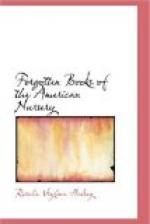The board of publication appointed by the American Sunday School Union—composed chiefly of clergymen of certain denominations—passed upon the merits of the many manuscripts sent in by piously inclined persons, and edited such of them as proved acceptable. The marginal notes on the pages of the first edition of an old Sunday-school favorite bear witness to the painstaking care of the editors that the leaflets, tracts, and stories poured in from all parts of the country should “shine by reason of the truth contained,” and “avoid the least appearance, the most indirect insinuations, of anything which can militate against the strictest ideas of propriety.” The tales had also to keep absolutely within the bounds of religion. Many were the stories found lacking in direct religious teaching, or returned because religion was not vitally connected with the plot, to be rewritten or sent elsewhere for publication.
The hundreds of stories turned out in what soon became a mechanical fashion were of two patterns: the one of the good child, a constant attendant upon Sabbath School and Divine Worship, but who died young after converting parent or worldly friend during a painful illness; the other of the unregenerate youth, who turned away from the godly admonition of mother and clergyman, refused to attend Sunday-school, and consequently fell into evil ways leading to the thief’s or drunkard’s grave. Often a sick mother was introduced to claim emotional attention, or to use as a lay figure upon which to drape Scripture texts as fearful warnings to the black sheep of the family. Indeed, the little reader no sooner began to enjoy the tale of some sweet and gentle girl, or to delight in the mischievous boy, than he was called upon to reflect that early piety portended an early death, and youthful pranks led to a miserable old age. Neither prospect offered much encouragement to hope for a happy life, and from conversations with those brought up on this form of religious culture, it is certain that if a child escaped without becoming morbid and neurotic, there were dark and secret resolves to risk the unpleasant future in favor of a happy present.
The stories, too, presented a somewhat paradoxical familiarity with the ways of a mysterious Providence. This was exceedingly perplexing to the thoughtful child, whose queries as to justice were too often hushed by parent or teacher. In real life, every child expected, even if he did not receive, a tangible reward for doing the right thing; but Providence, according to these authors, immediately caused a good child to become ill unto death. It is not a matter for surprise that the healthy-minded, vigorous child often turned in disgust from the Sunday-school library to search for Cooper’s tales of adventure on his father’s book-shelves.
The correct and approved child’s story, even if not issued under religious auspices, was thoroughly saturated with religion. Whatever may have been the practice of parents in regard to their own reading, they wished that of the nursery to show not only an educational and moral, but a religious tendency. The books for American children therefore divided themselves into three classes: the denominational story, to set forth the doctrines of one church; the educational tale; and the moral narrative of American life.




